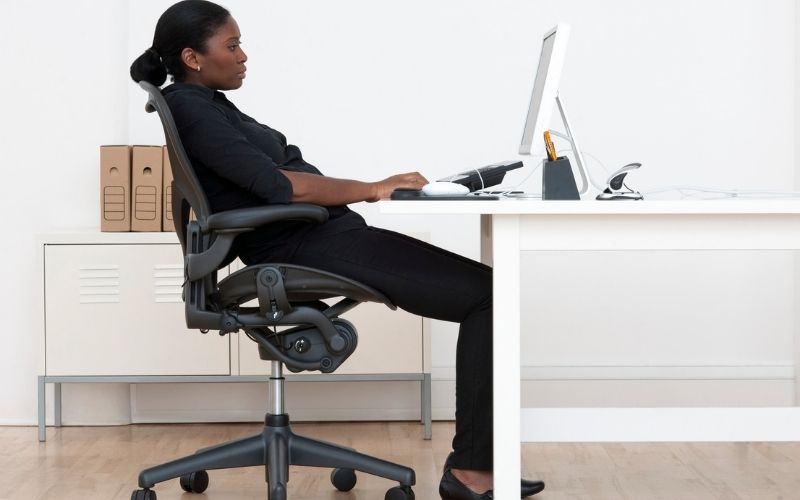Imagine this.
You’re sitting in front of the computer doing classwork or finishing your work assignment. Then, you notice a stinging sensation on your lower back.
What position did you imagine yourself in?
I bet you imagined yourself slouching.
You aren’t alone.
Many of us know the importance of proper posture. But many of us still fail to sit up straight throughout the entire duration we’re working at our desks.

Many of us still catch ourselves slouching over despite wanting to stop.
What then, do we do to stop slouching at our desks?
There are many ways. Taking frequent breaks, exercising, and using the right devices are just some of them.
If you wish to know more, read on.
Table of Contents
Why do I slouch over when I sit?
The key to stopping a slouch is by knowing the reason why it happens. This way, you can change or minimize whatever is causing that slouch and maintain proper posture when you sit.
There are five main reasons why we slouch over when we sit.
Let’s take a look at them one by one.
Tiredness and stress

If you’ve been working all day, it’s inevitable to feel tired. As the day goes, you’ll want to just sink on your chair, let go, and relax. This is why despite starting with a relatively good posture, you still end up slouched over as the day goes by.
Also, if you’re feeling stressed, your muscles tend to contract overly due to tension. You also end up breathing more shallowly, thus resulting in a slouched posture.
Poor muscle balance
If you have an idle lifestyle and spend most of your day sitting in front of the computer, your muscles may have weakened. Your muscles may also have become out-of-balanced.
Out-of-balanced muscles often result in a slouch because the back muscles elongate and the front muscles (shoulder and neck) shorten.
Wrong chair

If you’re using the wrong chair while working at your desk, you might be unconsciously finding ways to relax your back. You may end up moving forward and slouching over, or you may end up slinking down to relieve the pressure on your spine.
Either way, both results aren’t good for your posture and can weaken your muscles over time. Instead of just an occasional slouch, you may end up with a permanent one.
Low screen

If your screen or book is positioned too low, your body will find ways to compensate for the height difference. This can happen in two ways.
The first one is that you’ll scoot your entire body down to maintain a level line of sight with your screen or book. The second one is that you’ll tilt your neck down and hunch your back to keep your screen at eye level. As a result, you end up slouched over and with poor posture.
Genetics
Some of us are, unfortunately, predisposed to slouching because of heredity. There’s this concept of hereditary posture, which means we inherit our postures from our parents. So if either of your parents slouches often, there’s a good chance you will too.
There’s also this genetic disease called Scheuermann’s disease in which children develop a deformity on their spine. This results in an exaggerated curve on the middle part of their spine.
How do I stop slouching while sitting?
Now that you know the reasons for your slouch, let’s talk about ways to stop. Here are some tips.

- Take frequent breaks while working to avoid fatigue and stress.
- Avoid reclining your chair too far back when you work.
- Strengthen your muscles by exercising and stretching regularly.
- Place your screen or book at arm’s length and eye level.
- Invest in a chair with good lumbar support.
- Use posture correctors and other assistive devices when you work.
- Do some desk exercises to reduce strain on your body.
- Consider joining Zumba or yoga classes to combat slouch.
- Get help from a chiropractor or a reliable health professional.
If none of these tips work in helping you stop your slouch, visit your doctor. They can help find out if there is an underlying genetic or medical condition that’s causing that slouch.
How can I improve my posture at my desk?
Improving your sitting posture doesn’t happen overnight. But by following the tips below you can lay the foundation for a better posture every time you work.
So before you start working, make sure that your screen, table, and chair are positioned properly.

The screen shouldn’t be too far, too near, too high, or too low. Same with the chair and table.
Next, when you sit, avoid leaning forward to your desk.
Instead, sit with your back against your chair with your shoulders pulled back and chest thrust forward. You should also pull your head back and keep it aligned with your ears.
Then, place your feet flat on the floor when you sit.
This keeps your spine straight and avoids putting pressure on your tailbone. If possible, avoid crossing your legs when you sit. Not only is it bad for posture, but it’s also bad for your circulation.
While working, don’t forget to take breaks to avoid muscle fatigue.
Best devices in stopping a slouch
Sometimes, we need extra help in keeping our posture straight. So here are some products that can help.
Lumbar Support Pillow for Office Chair
A lumbar support pillow isn’t your average pillow. It’s designed to specifically support your back while sitting down. With its ergonomic design, you can maintain a proper sitting posture for hours with little to no discomfort.
Regular use of this lumbar support pillow results in back and neck pain relief and an overall better sitting posture.
Upright GO S New Posture Trainer and Corrector
If you’re looking for a discreet and high-tech way to combat your slouch, this posture trainer and corrector is what you need. This wearable device can be attached to your upper back to monitor your posture. Once it senses you slouching, the device vibrates to remind you to sit straight.
You can calibrate the Upright GO S through the Upright app.
Flexguard Posture Corrector
Flexguard Posture corrector is a combination between a back brace and a posture corrector. When worn, this product pulls back your shoulders to keep your posture upright. It helps improve your spinal alignment and relieve your back pain.
The product comes in four different sizes and can be worn by both men and women.
Conclusion
Slouching is an all-too-common problem for many of us. The good thing is that we don’t have to suffer through it forever.
If you do daily stretches and exercises as well as invest in some posture assistive devices, you can improve your posture. Taking frequent breaks while working also helps ease muscle strain and prevent slouching.
If those don’t work, you should consider getting checked for underlying medical conditions.

My name is Vance, and I am the owner of To Ergonomics. Our mission is to improve your workflow by helping you create a supportive and welcoming environment. We hope that you’ll find what you’re looking for while you’re here.




